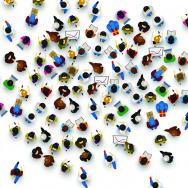To boost fundraising, charities should consider highlighting how giving can benefit donors themselves. According to new research co-authored by leading University of Chicago behavioral economist John List, nudging potential donors toward the “warm glow” of philanthropy can be more effective than emphasizing the importance of helping others.
Studying a charitable program in Alaska, the new working paper found that people who received postcards appealing to their sense of self were more likely to donate than those who received messages appealing to pure altruism.
“We found that messaging matters,” said List, the Kenneth C. Griffin Distinguished Service Professor of Economics and a pioneer in the use of field experiments in economic research. “More specifically, when we appealed to the value the donor will reap, people gave more than when we appealed to how the dollars will help recipients.
“This result surprised us, but is entirely consonant with a warm-glow model of giving: People give in part because they feel good from the act of giving.”
List co-authored the paper with James J. Murphy and Alexander G. James of the University of Alaska Anchorage, and Michael K. Price of the University of Alabama.
The economists partnered with a program popularly known as Pick.Click.Give., which encourages Alaskans to donate a portion of the annual dividend they receive from the state’s oil production revenues. During a 2014 marketing campaign, the researchers studied nearly 300,000 households, randomly assigning roughly 541,000 individuals into three buckets: a control group, and two treatment groups that received different postcards encouraging them to donate.
One message appealed to the readers’ sense of self (“Warm Your Heart”), while the other highlighted the importance of helping others (“Make Alaska Better for Everyone”). The more personal message was the one that made a difference.
Observing over $3.1 million in donations from more than 26,000 people, the economists discovered that those who received the “Warm Your Heart” message were approximately 4.5 percent more likely to give than those in the control group, who did not receive a postcard. Those individuals also gave average donations that were nearly 20 percent larger than the donations from the control group—around a dollar more.
Postcards saying, “Make Alaska Better,” on the other hand, produced a negligible increase in giving compared to the control group.
Building upon a long history of innovative economic research at UChicago, List has long championed the value that field experiments bring to the discipline. Real-world interventions, List argues, allow economists to test theories in areas ranging from educational outcomes to ride-sharing habits to the nature of giving.
“Field experiments allow us to take a glimpse under the hood, to go beyond anecdotes and ‘gut feelings’ for why people give to charities,” he said.
List’s past research into philanthropy has focused on the relationship between donors and charities, including gender disparities in giving and the effects of door-to-door canvassing. In 2012, his work helped secure a $4.8 million grant for UChicago to establish the Science of Philanthropy Initiative.
These latest results, he said, further sketch out the motivations for giving, and provide a better strategic framework for how charities and non-profit organizations can improve fundraising.
However, List also suggested that more research is necessary to identify alternative explanations for the behavior. The message appealing to pure altruism, for instance, could have affected how impactful donors perceived their own contributions to be within the context of an entire state population.
“This new work is a tiny step in the direction of helping us really understand donor motivations,” List said. “Once these basic initial tests provide us an insight, we can roll up our sleeves and design large-scale field experiments to understand the mechanisms behind the original result.
“In this case, until we fully grasp such mechanisms and whether the results generalize to other donors and charitable projects, we cannot reap the true rewards of field experimentation.”

